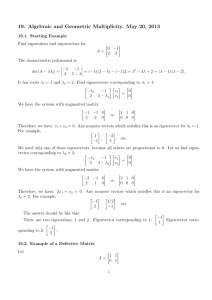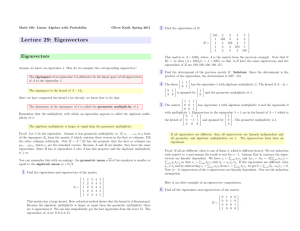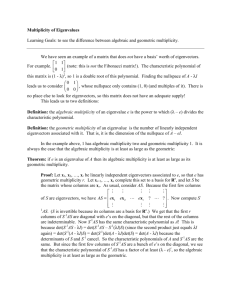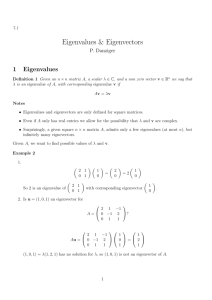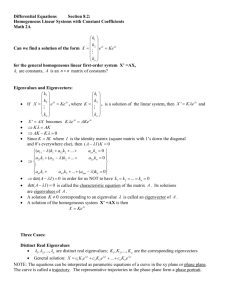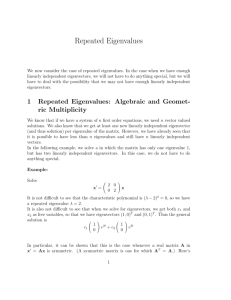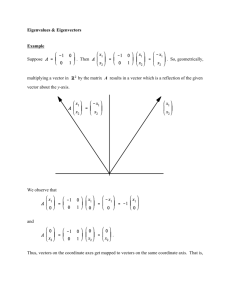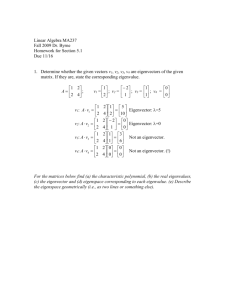CALCULATING EIGENVECTORS Math 21b, O.Knill
advertisement
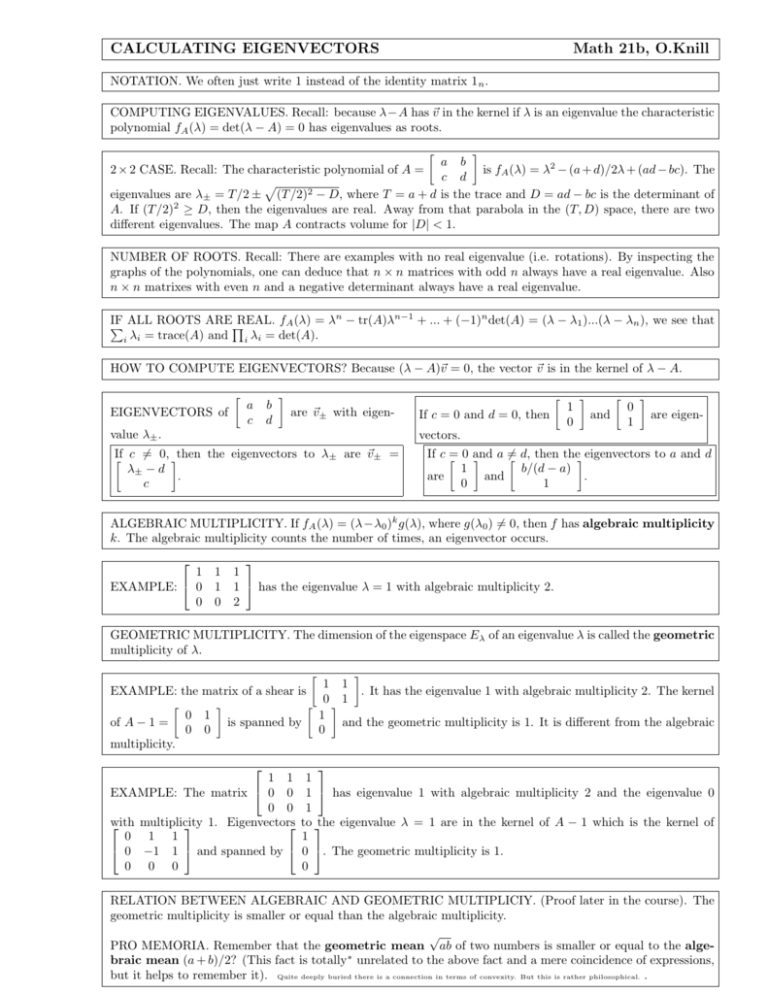
CALCULATING EIGENVECTORS Math 21b, O.Knill NOTATION. We often just write 1 instead of the identity matrix 1 n . COMPUTING EIGENVALUES. Recall: because λ−A has ~v in the kernel if λ is an eigenvalue the characteristic polynomial fA (λ) = det(λ − A) = 0 has eigenvalues as roots. a b 2 × 2 CASE. Recall: The characteristic polynomial of A = is fA (λ) = λ2 − (a + d)/2λ + (ad − bc). The c d p eigenvalues are λ± = T /2 ± (T /2)2 − D, where T = a + d is the trace and D = ad − bc is the determinant of A. If (T /2)2 ≥ D, then the eigenvalues are real. Away from that parabola in the (T, D) space, there are two different eigenvalues. The map A contracts volume for |D| < 1. NUMBER OF ROOTS. Recall: There are examples with no real eigenvalue (i.e. rotations). By inspecting the graphs of the polynomials, one can deduce that n × n matrices with odd n always have a real eigenvalue. Also n × n matrixes with even n and a negative determinant always have a real eigenvalue. IF REAL. fA (λ) = λn − tr(A)λn−1 + ... + (−1)n det(A) = (λ − λ1 )...(λ − λn ), we see that P ALL ROOTS AREQ i λi = trace(A) and i λi = det(A). HOW TO COMPUTE EIGENVECTORS? Because (λ − A)~v = 0, the vector ~v is in the kernel of λ − A. EIGENVECTORS of value λ± . a c b d are ~v± with eigen- If c = 0 and d = 0, then vectors. If c 6= 0, then the eigenvectors to λ± are ~v± = λ± − d . c 1 0 and 0 1 are eigen- If c = 0 and a 6= d, then the eigenvectors to a and d b/(d − a) 1 . and are 1 0 ALGEBRAIC MULTIPLICITY. If fA (λ) = (λ−λ0 )k g(λ), where g(λ0 ) 6= 0, then f has algebraic multiplicity k. The algebraic multiplicity counts the number of times, an eigenvector occurs. 1 1 1 EXAMPLE: 0 1 1 has the eigenvalue λ = 1 with algebraic multiplicity 2. 0 0 2 GEOMETRIC MULTIPLICITY. The dimension of the eigenspace E λ of an eigenvalue λ is called the geometric multiplicity of λ. 1 1 . It has the eigenvalue 1 with algebraic multiplicity 2. The kernel EXAMPLE: the matrix of a shear is 0 1 1 0 1 and the geometric multiplicity is 1. It is different from the algebraic is spanned by of A − 1 = 0 0 0 multiplicity. 1 1 EXAMPLE: The matrix 0 0 0 0 with multiplicity 1. Eigenvectors 0 1 1 0 −1 1 and spanned by 0 0 0 1 1 has eigenvalue 1 with algebraic multiplicity 2 and the eigenvalue 0 1 to the eigenvalue λ = 1 are in the kernel of A − 1 which is the kernel of 1 0 . The geometric multiplicity is 1. 0 RELATION BETWEEN ALGEBRAIC AND GEOMETRIC MULTIPLICIY. (Proof later in the course). The geometric multiplicity is smaller or equal than the algebraic multiplicity. √ PRO MEMORIA. Remember that the geometric mean ab of two numbers is smaller or equal to the algebraic mean (a + b)/2? (This fact is totally∗ unrelated to the above fact and a mere coincidence of expressions, but it helps to remember it). Quite deeply buried there is a connection in terms of convexity. But this is rather philosophical. . EXAMPLE. What are the algebraic and geometric multiplicities of A = 2 0 0 0 0 1 2 0 0 0 0 1 2 0 0 0 0 1 2 0 0 0 0 1 2 ? SOLUTION. The algebraic multiplicity of the eigenvalue 2 is 5. To get the kernel of A − 2, one solves the system of equations x4 = x3 = x2 = x1 = 0 so that the geometric multiplicity of the eigenvalues 2 is 4. CASE: ALL EIGENVALUES ARE DIFFERENT. If all eigenvalues are different, then all eigenvectors are linearly independent and all geometric and algebraic multiplicities are 1. PROOF. from 0 and Pare linearly dependent. We have P assume the eigenvectors P P Let λi be an eigenvalue different vi = j6=i bj vj with bP vi = j6=i aj vj and λi vi = Avi = A( j6=i aj vj ) = j6=i aj λj vj so that P j = aj λj /λi . a v from v = If the eigenvalues are different, then a = 6 b and by subtracting v = j j i j j i j6=i bj vj , we get j6=i P 0 = j6=i (bj − aj )vj = 0. Now (n − 1) eigenvectors of the n eigenvectors are linearly dependent. Use induction. CONSEQUENCE. If all eigenvalues of a n × n matrix A are different, there is an eigenbasis, a basis consisting of eigenvectors. EXAMPLE. A = 1 0 1 3 has eigenvalues 1, 3 to the eigenvectors 1 0 −1 1 . EXAMPLE. (See homework problem 40 in the book). Photos of the Swiss lakes in the text. The pollution story is fiction fortunately. The vector An (x)b gives levels the pollution in the three lakes (Silvaplana, Sils, St Moritz) after n weeks, where 0.7 0 0 100 A = 0.1 0.6 0 and b = 0 is the initial pollution. 0 0.2 0.8 0 100 80 60 40 20 0 There is an eigenvector e3 = v3 = 0 to the eigenvalue λ3 = 0.8. 1 0 1 There is an eigenvector v2 = 1 to the eigenvalue λ2 = 0.6. There is further an eigenvector v1 = 1 −1 −2 to the eigenvalue λ1 = 0.7. We know An v1 , An v2 and An v3 explicitly. How do we get the explicit solution An b? Because b = 100 · e1 = 100(v1 − v2 + 3v3 ), we have 4 6 An (b) = 8 10 100An (v1 − v2 + 3v3 ) = 100(λn1 v1 − λn2 v2 + 3λn3 v3 ) 1 0 0 100(0.7)n 100(0.7n + 0.6n ) = 100 0.7n 1 + 0.6n 1 + 3 · 0.8n 0 = n n n −2 −1 1 100(−2 · 0.7 − 0.6 + 3 · 0.8 )
